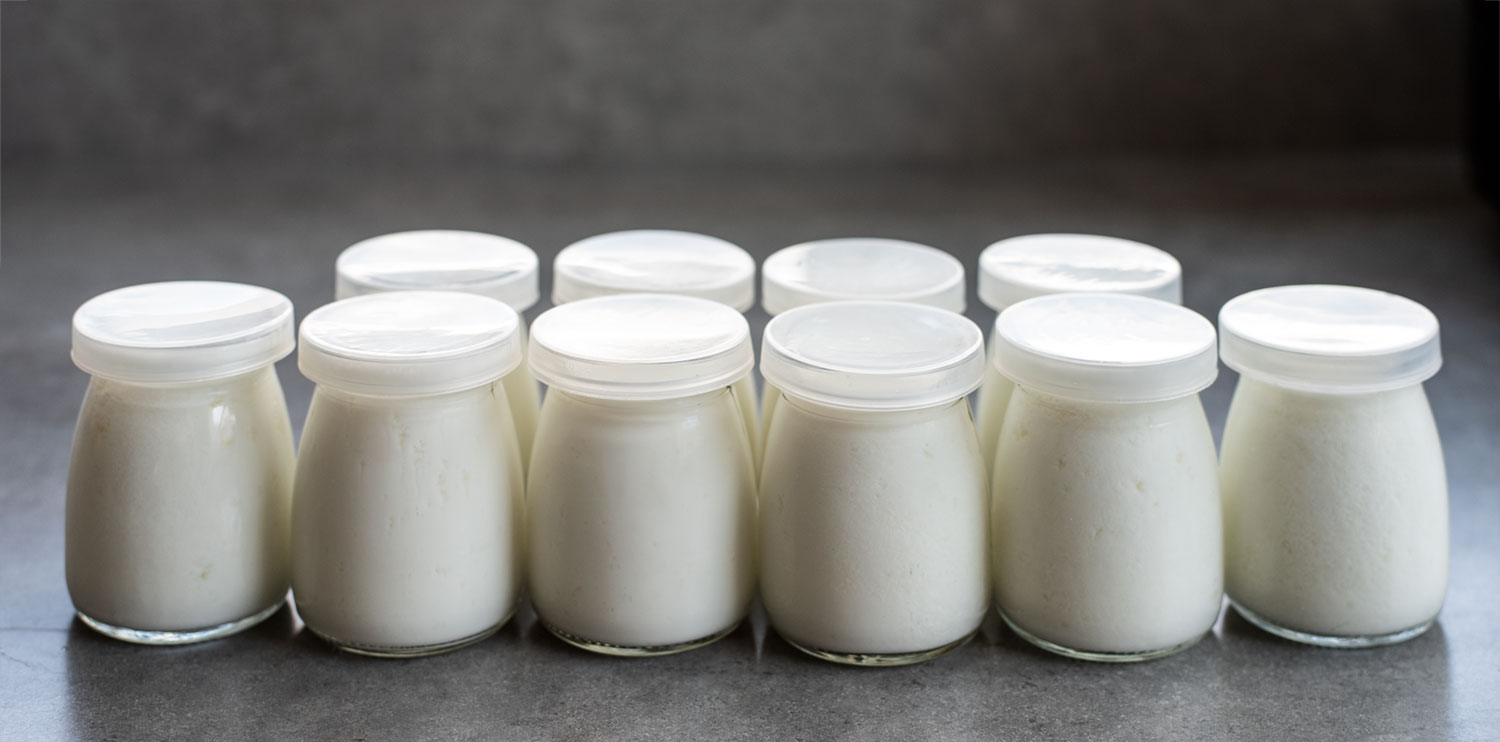Yearning for Yogurt
Photos by Forrest Anderson
Ah yogurt! Along with bread and fruit, it’s the first food I look for when I travel and a daily staple that my husband makes at home. I’m obsessed with it, especially when it comes in adorable little ceramic and glass bottles used in some countries.
Yogurt is seen as a health food all over the world because it is a source of calcium and many people who have lactose intolerance can eat it. Yogurt worldwide is close to a 30 billion U.S. dollar industry and it is growing. Global sales of yogurt exceed sales of milk.
Yogurt is produced by bacterial fermentation of milk, called yogurt culture. The fermentation of lactose by the bacteria produces lactic acid, which acts on the milk protein to give yogurt its creamy texture and tartness. Cow’s milk is the most common milk from which yogurt is made, but water buffalo, goat, sheep, mare, camel and yak milk also are used in some areas. In recent years, plant-based milks such as soy milk and coconut milk are used to make yogurt.
To produce yogurt, milk is heated, usually to about 185 °F, so the milk proteins won’t form curds. The milk is then allowed to cool to about 113 °F and a small amount of yogurt culture is mixed into it. The temperature is maintained for 4-12 hours to allow fermentation. Yogurt is more or less sour and thick depending on the amount of time that the temperature is maintained.
Yogurt is thought to have been created in Mesopotamia as far back as 5000 BC. The name probably comes from a Turkish word, yoğurmak, that means to knead, curdle or thicken. The g is silent, so as the word spread into different languages, some of them adopted forms of the word that have no g. For example, yogurt in French is yaourt. Central Asian nomads are believed to have stored goat’s milk in canteens made of animal stomaches and carried it with them. The milk would thicken and become tart. In other words, it became yogurt. The making of it spread across the Central Asian and East Asian steppes. Genghis Khan’s army ate it to give them stamina and strength in battle.
Yogurt has long been popular across a wide swath of the world from Turkey eastward to Japan and southward to Indonesia and throughout Europe and the Americas. In India, a combination of yogurt and honey was called “the food of the gods.” The Indian Emperor Akbar had yogurt flavored with cinnamon and mustard seeds. Persian traditions associated the ancient prophet Abraham’s longevity with the regular consumption of yogurt. Some historians have speculated that the Biblical reference to the land of milk and honey referred to yogurt as yogurt and honey were eaten together. Pliny the Elder noted that some"barbarous nations" knew how "to thicken the milk into a substance with an agreeable acidity." Yogurt until the 1900s was a staple in the diets of people in Russia, Central Asia and the Caucasus, Western Asia, Central Europe, and the Indian subcontinent. It was for thousands of years the only way of preserving milk safely other than drying it.
Yogurt consumption is more common among healthier, leaner, more highly educated people and more common among women and nonsmokers. Some research has shown that yogurt can have positive effects on the gut, is associated with a reduced risk for gastrointestinal disease, improves lactose intolerance in children, and has a positive effect on alleviating cardiovascular disease, type 2 diabetes, allergies, respiratory disease, dental and bone health and pregnancy outcomes.
Here’s a rundown on how it is eaten and made in countries where it is popular, along with our painstakingly tested home recipe:
France
In France, yogurt is a national obsession and average per capita consumption is 44 pounds per year. The yogurt aisle in a French store is a thing of beauty. There are yogurts with fresh fruit, chocolate, caramel and chestnut; desserts that contain yogurt, including cakes, tiramisu and crème brûlée; organic yogurts; sheep and goat milk yogurts; and nondairy yogurts. There are mass-produced yogurts and yogurts made in small amounts on family farms. The texture of French yogurt is lighter than the Greek yogurts preferred by Americans. Yogurt packaging can be beautifully designed - some French yogurt containers are small, adorable ceramic pots and glass bottles.
Yogurt caught on hundreds of years ago in France when a French king, Francois 1, suffered from severe diarrhea that his doctors couldn’t cure. His ally Suleiman the Magnificent, sultan of the Ottoman Empire, sent him a doctor who prescribed yogurt and Francois recovered. Voila! The cure spread and the French love of yogurt was born.
In the early 20th century, a medical student in Bulgaria isolated a bacteria native to his country’s yogurt called Lactobacillus which wasn’t naturally present in the human intestinal tract. Using this research, a scientist at the Institute Pasteur in Paris linked the bacteria to longevity in Bulgarian peasants. This link has not been proven, but yogurt became tied to health in the French public mind.
In the 20th century, two of the world’s largest multinational yogurt companies appeared in France: Danone, which relocated to Paris after having been founded in Spain in 1919; and Yoplait. Yoplait’s formation coincided with the advent of television in French homes, and many French remember early yogurt television ads.
The majority of French eat at least one serving of yogurt daily, compared to only 6 percent in the United States. French who live abroad commonly complain with good reason that they miss not eating French yogurt. French yogurt uses whole milk and the ingredients are poured directly into the pots the yogurt will be consumed in, put aside in a hot room for eight hours and it’s done. French yogurt has a luxuriously smooth, creamy texture and sweet taste. Unlike Greek yogurt, it isn’t strained. The French typically eat yogurt as a dessert as well as a snack.
We use the French yogurt Oui as the yogurt starter for our homemade yogurt.
Ireland, the United Kingdom, Australia and the United States
Ireland is known for its creamy churn-made yogurt. Otherwise, sweetened and flavored yogurt is popular in these countries. Yogurt in the United States is a sweetened, strong flavored thick and often frozen snack or dessert. In the 1950s and 1960s, it was presented as a health food by scientists like Hungarian-born bacteriologist Stephen A. Gaymont. In 1966 Colombo Yogurt, sweetened yogurt and added fruit preserves, creating "fruit on the bottom" style yogurt. In 2017, the average American ate almost 14 pounds of yogurt. The biggest concern with yogurt in these countries is the often-high sugar content.
Russia
Yogurt is a stable food in Russia. The Caucasian region has a type of yogurt called matsoni which, again, has a reputation of contributing to the longevity of the people there. Cold yogurt soups are also popular.
China
The Chinese prefer to drink yogurt and actively look for probiotics in yogurt. The Chinese consider yogurt a healthy food partly because the population is about 90 percent lactose intolerant and yogurt is a dairy product that they can eat.
A version of yogurt called nai lao or swan nai, traditionally has been sold in Beijing and other northern cities in ceramic pots with paper coverings. It still is sold, but more commonly in disposable sealed cups now. It commonly is eaten with a straw or spoon on the street. The ceramic pots have become collectors’ items. Nai lao was a steppe import, having been brought to Beijing by northern non-Chinese conquerers. Traditionally, the fermentation in nai lao came from rice wine rather than a yogurt culture, but some nai lao is made just like regular yogurt – by adding a small amount of yogurt to scalded milk and letting it sit in a warm place for several hours.
Yogurt in China often is flavored with tropical and other fruits and sometimes tapioca pearls are added to it. One Chinese yogurt company uses the name of the Bulgarian village Momchilovtsi to sell yogurt drinks, which has made the village popular in China. Foreign yogurt and yogurt packaged and marketed with an apparent foreign connection sells well in China because of a common perception that foreign products are higher quality and safer than Chinese ones. Chinese consumers also like new trends, especially those marketed as promoting better health and healthy beauty.
Chinese consume yogurt for breakfast, after dinner and in the afternoon as a snack. Sales of drinkable yogurt are growing in China.
In Tibet, yak milk is made into yogurt.
India, Bangladesh and Nepal
In India, a variety called dahli is made. This type of yogurt is one of the five elixirs used in Hindu ritual. Sweetened dahli is common in eastern India. India has hundreds of ways of preparing yogurt. Yogurt is common in various forms in Nepal for local festivals, marriage ceremonies, religious celebrations and parties. In India, drinks called lassi are sweetened with sugar or honey and fruit are made. In southern India, yogurt is combined with water, salt and spices to make a summer drink called moru. Borhani (or burhani) is a spicy yogurt drink from Bangladesh served at weddings and feasts.
Indonesia
Yogurt is made from water buffalo milk and fermented in bamboo tubes.
Turkey
Most yogurt eaters in Turkey like it plain as part of a warm meal.
Poland
The Polish love flavored yogurt and eat it as a snack.
Greece
Yogurt is served as a side dish with savory foods. Strained yogurt is used as dips or sauces and flavors and vegetables are added to it.
Japan
Bulgarian yogurt was introduced into Japan in the early 1970s, marketed heavily as a health food. Like everything else, the Japanese took it and made it exquisite. Japan now has a wide variety of yogurts, my favorite of which is the fresh creamy plain yogurt served in quaint glass jars in some hotels. Japan is now one of the world’s premier places for high-quality yogurt. The yogurt industry in Japan is worth $3.7 billion U.S. dollars annually. The Japanese Meiji Bulgaria Yogurt company, which has 43 percent of the Japanese market, marketed yogurt as a healthy food with anti-aging properties, with pictures of pastoral scenery and healthy elderly people. It is so popular in Japan that it has given Bulgaria’s international image and integration with the global market a boost.
The Mediterranean and Middle East
In Northern Iran, Mâst Chekide is a variety of sour kefir yogurt. It is mixed with a pesto-like water and fresh herb purée called delal. It is eaten with vegetables and also added to soups.
In Greece, Bulgaria, Lebanon and Syria, yogurt-based salads are made. In Jordan, jameed, a salted dried yogurt, is prepared. Zabadi, or yogurt made from Egyptian water buffaloes, is made in Egypt and is associated with Ramadan fasting because it is believed to prevent thirst during all-day fasting.
Strained yogurt, which has a consistency between yogurt and cheese, is used for sandwiches in the Middle East. Olive oil, cucumber slices, olives and green herbs are added to it. It can be further thickened into balls that are preserved in olive oil for a few weeks. It is used along with onions, meat and nuts in pies.
Our Recipe for Creamy Mild Yogurt
5 cups whole milk
1 tbsp. sugar
1 tsp. real vanilla flavoring
1 tbsp. Oui vanilla yogurt
Pour the 5 cups of whole milk into a large glass bowl.
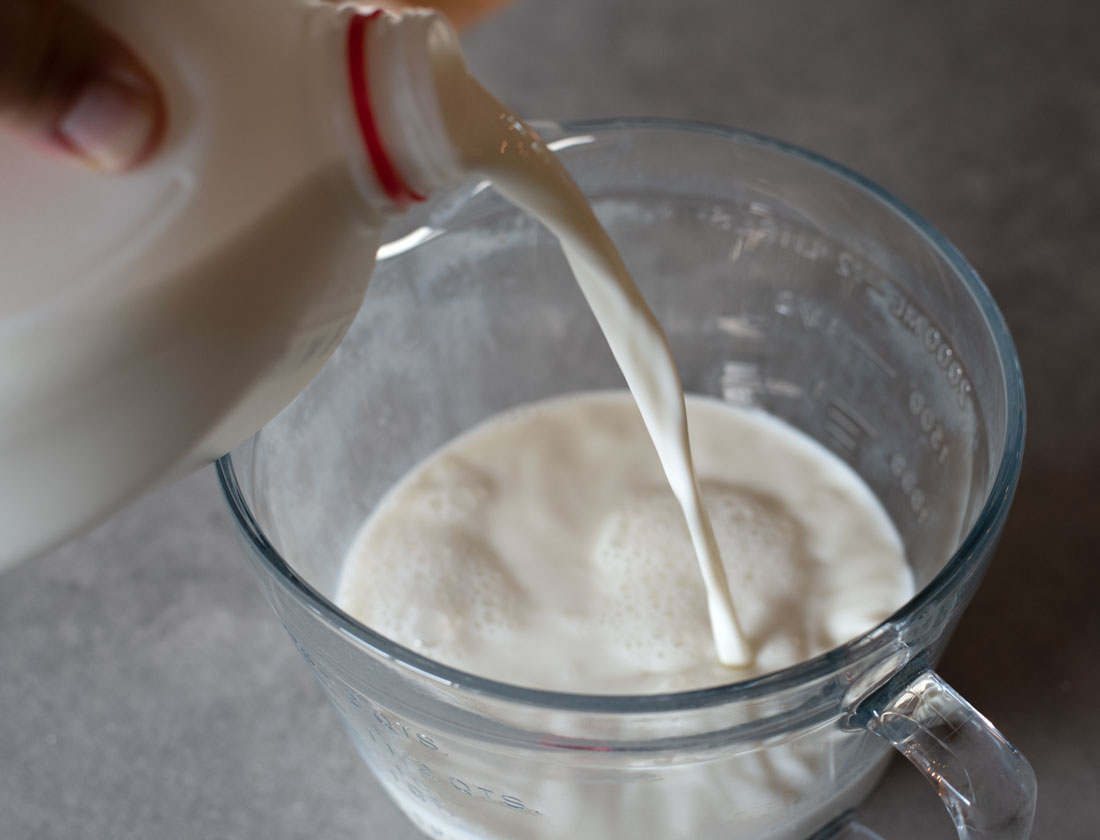
Microwave on high for 8 minutes.

Cool at room temperature for 40 minutes.
Carefully remove the cheese-like film from the surface.

Add the sugar...

Vanilla....
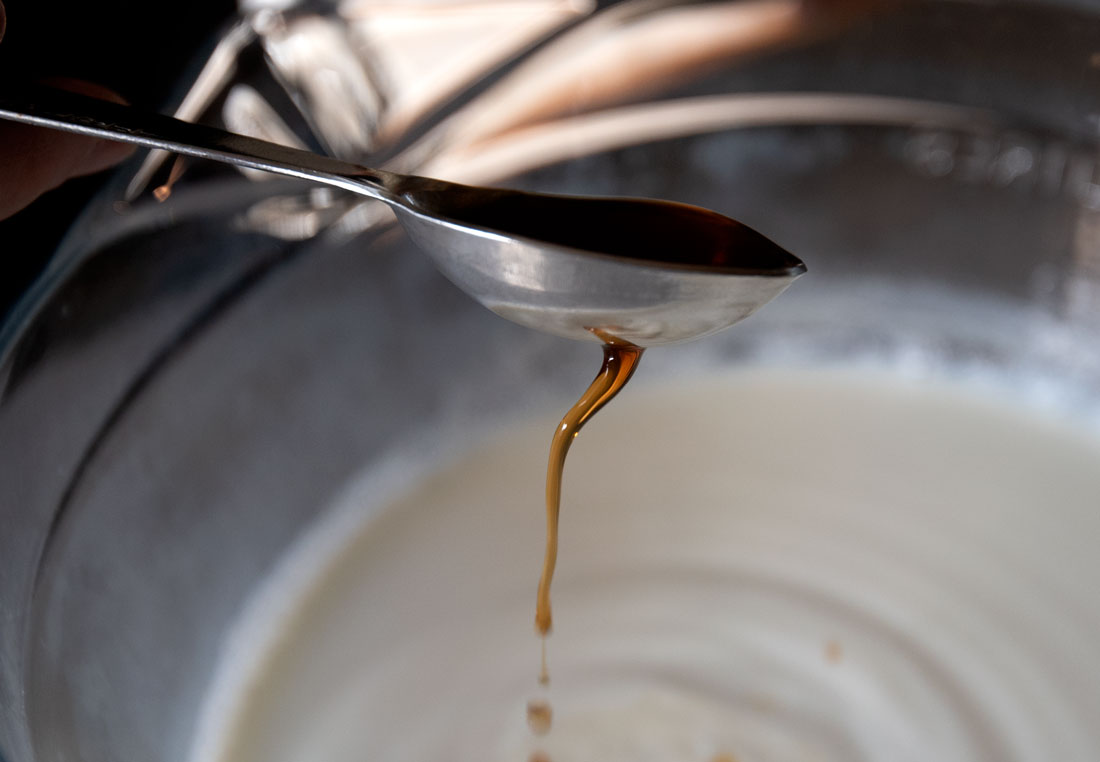
and 1 tbsp. Oui vanilla yogurt.

Stir and pour into a yogurt maker.
Cook for 7-8 hours.

Whisk.
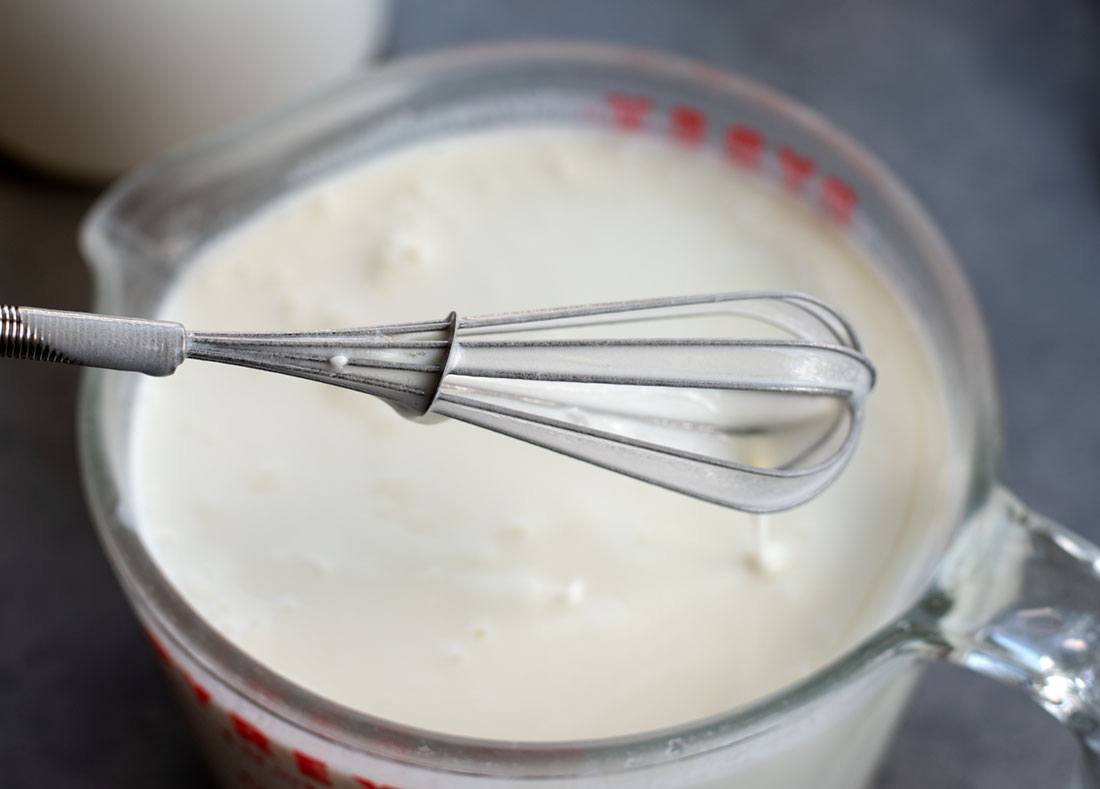
Pour into small yogurt bottles and cover with plastic lids.
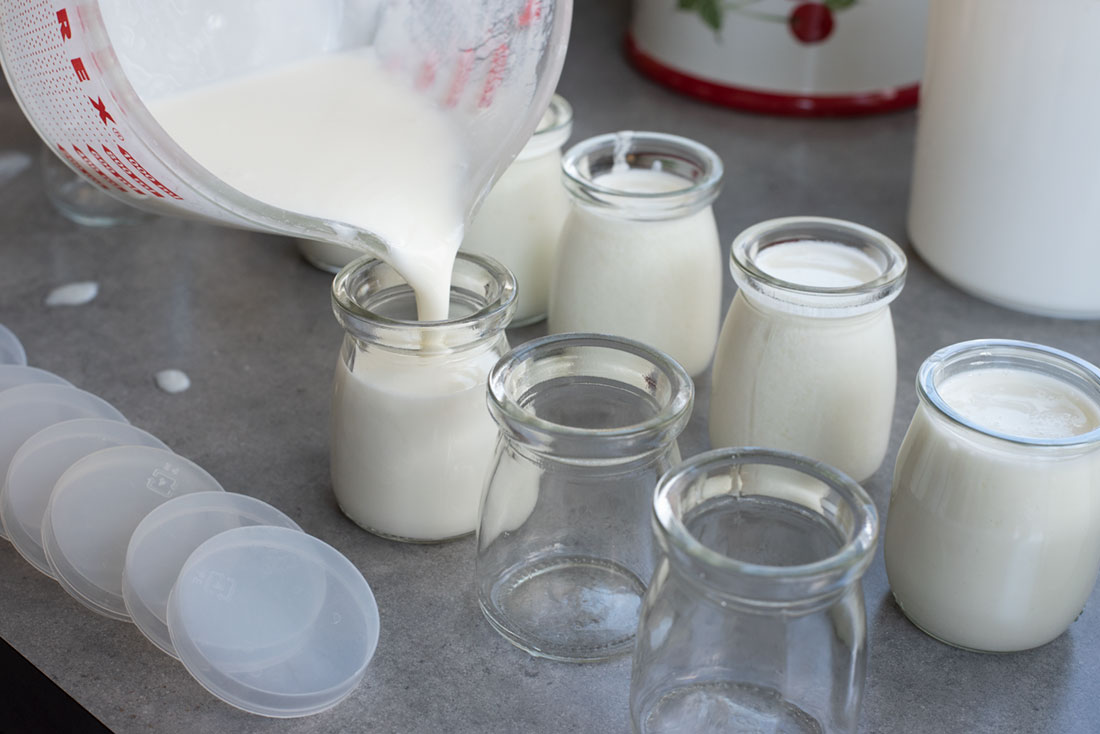
Refrigerate.
Check out these related items
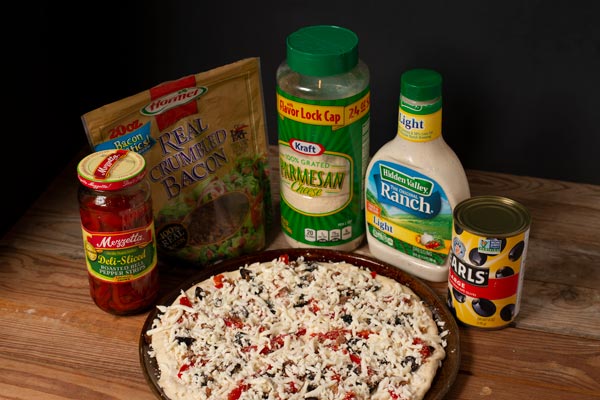
Store What You Eat Guidelines
The pandemic has been a major wake-up call about planning, home storage and preparation for crises. Here are some guidelines.

The World is Flat (Bread)
Flatbreads are oldest, easiest breads and the most modern - pizza and tortillas are among the most popular foods. See our recipes.

Creating an Easy Cooking System
Creating a simple, versatile cooking system can enable you to serve delicious meals at home even on days when you are swamped.
